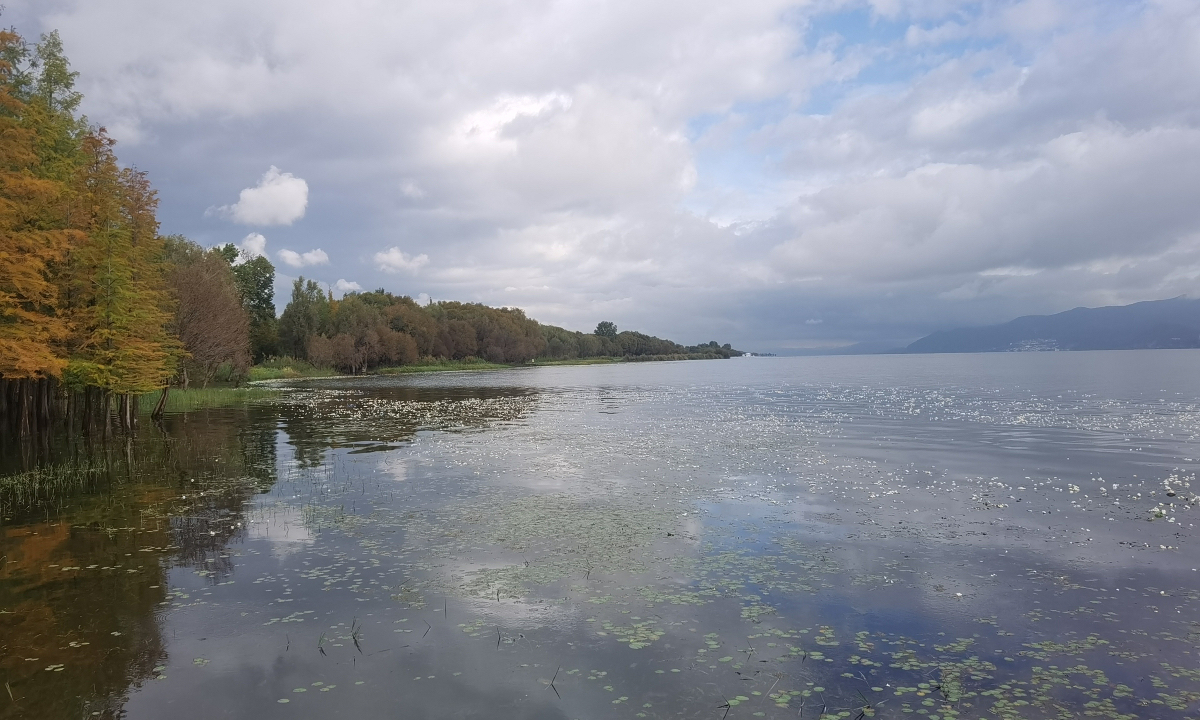Erhai Lake, located in Southwest China’s Yunnan Province, boasts breathtaking natural beauty with its crystal-clear waters reflecting the surrounding snow-capped mountains and lush greenery. The serene atmosphere of the lake creates a tranquil haven for visitors, allowing them to unwind and immerse themselves in the peaceful surroundings.
In recent years, the environment of Erhai Lake has been significantly improved, resulting in more picturesque scenery.
The lake located in the city of Dali sits at about 2,000 meters above sea level and covers more than 250 square kilometers. Dubbed the “mother lake” by local residents, the ear-shaped freshwater lake attracts tens of millions of tourists every year.
This natural wonder, however, has undergone massive painstaking transformation, from near destruction to absolute conservation. Due to the rapid population growth and expansion of tourism, pollution-induced eutrophication worsened over last decade in Erhai Lake, and the ottelia acuminata, a flower endemic to southern China, was decimated by the outbreak of blue algae.
To better protect the Erhai Lake and preserve its biodiversity, the Dali government struggled with firm determination to ban garlic cultivation, remove guesthouses, and explored a scientific lake management model over the last decade.
Today, along the Erhai Lake ecological corridor, seaweed flowers, widely seen as a “water quality indicator,” are blooming in large patches, a sign of the recovery of the ecological environment of Erhai Lake. It is also expected to bring more tangible benefits to local residents and people living in downstream areas of the Lancang-Mekong River.
Since the 1980s, due to excessive exploitation and lack of protection, the water quality of Erhai Lake deteriorated, leading to widespread outbreaks of blue-green algae.
In 2013, Erhai Lake experienced another large-scale outbreak of blue-green algae. At that time, Dali had become “a peaceful haven” for urban white-collar workers looking to escape from high-pressure city life, and the construction of homestays and guesthouses along the shores of Erhai Lake became a new trend.
Investors from other regions flocked to the rural areas around Erhai Lake, resulting in a sudden surge in the number of homestays.

Seaweed flowers, widely seen as the “water quality indicator,” bloom in large patches along the Erhai Lake ecological corridor. Photo: Hu Yuwei/GT
However, the rural areas around Erhai Lake lacked proper planning and inadequate infrastructure to cope with the rapid growth of tourism. In the winter of 2016, blue-green algae once again erupted in Erhai Lake.
By the end of November 2016, the Yunnan government took decisive measures to initiate a rescue operation, with the homestays and guesthouses along the shores of Erhai Lake being the first to be addressed.
Since December 2016, the Dali government has martialed multiple departments to jointly conduct law enforcement raids, resulting in the closure of a cluster of inns with insufficient documentation, and announced the closure and a rectification of a total of 2,498 restaurants and guesthouses around Erhai Lake until the pollution interception project was completed in June 2018. Since then, the measures have continually been upgraded.
Tea Xuewei, a Dali Water Affairs Bureau inspector, told the Global Times that the current Erhai Lake ecological corridor covers over 790 hectares of ecological restoration and wetland construction, and several environmental monitoring stations. It is equipped with a well-established 30-kilometer sewage pipeline network and five scientific research experimental bases with wetland restoration functions, further enhancing the biodiversity and stability of the Erhai Lake aquatic ecosystem.
According to the report by the Chinese Ministry of Ecology and Environment, the water quality of Erhai Lake has been rated as “excellent” for three consecutive years from 2020 to 2022. The transparency of the lake reached 2.29 meters in 2022, the highest level in nearly 20 years.
Flagship species such as black-and-white snub-nosed monkeys, Asian elephants, and green peacocks are seeing the recovery of their habitats in Yunnan.
As an emblematic species, the recovery of seaweed in Erhai Lake has also made great progress. Currently, the distribution area of seaweed in the entire lake has reached 92,000 square meters.
Experts believe that over 95 percent of the water pollution factors or initial problems faced by lakes in China are similar to those encountered by Erhai Lake. This means that the successful lessons from the governance of Erhai Lake can be applied to the governance of other lakes in China and even the world.
On October 24, a four-day media fieldtrip for the 2023 Lancang-Mekong Water Resources Cooperation was launched in Dali, attracting 10 Chinese and foreign media outlets to conduct in-depth research on the construction of an ecological civilization model. The successful river and lake protection and governance in the Lancang-Mekong River basin is impressive, and sparks confidence among other riparian countries due to the wide applicability of conservation methods.
(Global Times)



